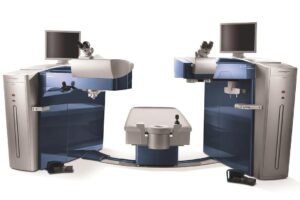Do you dream of waking up with clear vision? If you are ready to have clear vision without needing glasses or contact lenses, you might wonder which vision correction procedure is right for you.
With so many options, figuring out which procedure will offer you the clearest vision possible can be challenging. Keep reading to learn about some of the best vision correction procedure options available to get you started on your clear vision journey!
LASIK

The most well-known vision correction procedure is LASIK. LASIK, which stands for Laser In-Situ Keratomileusis, can correct nearsightedness, farsightedness, and astigmatism.
There’s no doubt that LASIK is the most commonly performed vision correction procedure. At Batra Vision, we’ve completed the procedure on over 10,000 happy and satisfied patients!
During LASIK, your surgeon first creates a hinged corneal flap. They will then lift the flap to allow a laser to reshape the cornea and correct refractive errors.
The flap gets put back into place on the cornea. When it’s put back into place, the flap starts healing almost immediately. LASIK surgery is often a patient’s first choice for vision correction because of the short recovery times and consistent results.
Amongst LASIK patients, 97% report 20/40 vision following the procedure, and 90% of patients report 20/20 vision.
Wavefront Technology

If you find out you’re a good LASIK candidate, you may want to consider Wavefront technology for your procedure. With Wavefront technology, your surgeon can create a highly accurate map of your eye, helping to identify unique imperfections that specifically affect your clear vision.
The map of your eye created with Wavefront technology allows your eye surgeon the utmost precision during the LASIK procedure, resulting in high-quality results and shorter recovery times. Many Wavefront patients even report that visual contrast is better defined following LASIK with the technology.
Epi-LASIK

If you have certain eye conditions, like thin corneas or enlarged pupils, you may not be a suitable candidate for LASIK. If so, another vision correction option for you might be Epi-LASIK, which stands for Epithelial Laser In-Situ Keratomileusis.
The Epi-LASIK procedure is similar to LASIK. However, during Epi-LASIK, the surgeon creates a much thinner flap.
After creating this thinner flap, only the thin outer layer of the cornea gets lifted. The thin outer layer is the epithelium. After lifting the epithelium, the cornea gets reshaped in a way that’s virtually identical to during a LASIK procedure.
While the recovery time for Epi-LASIK is slightly longer as the epithelium reattaches to the cornea, the vision correcting results are comparable to LASIK. Like LASIK, Epi-LASIK can correct nearsightedness, farsightedness, or astigmatism.
Photorefractive Keratectomy (PRK)

Photorefractive keratectomy, commonly called PRK, is an excellent vision-correcting procedure if you have refractive errors like nearsightedness, farsightedness, or astigmatism. PRK is often a good choice for patients that don’t qualify for LASIK or Epi-LASIK.
Like Epi-LASIK, some eye conditions that make PRK a better choice than LASIK include having thin corneas, large pupils, and an increased risk of trauma near the eye. During a PRK procedure, you’ll have a laser used to remove the epithelium and then reshape the cornea.
Reshaping the cornea allows light to hit the cornea correctly. After PRK, you’ll have your cornea covered up with a special contact lens “bandage”. The bandage protects the cornea as the epithelium regrows.
While the vision-correcting results of PRK are comparable to LASIK and Epi-LASIK, the recovery time from the procedure is usually much longer. Immediate recovery usually lasts 3-5 days, but it can take up to three months for the epithelium to fully heal.
Lens Implant Surgery
Lens implant surgery can correct vision for a wide range of eye problems. During lens implant surgery, you’ll have your natural lens removed and replaced with an artificial lens.
People most commonly consider lens implant surgery (cataract surgery) a surgical treatment for cataracts. But the procedure is also a way of correcting vision for patients with extreme nearsightedness or farsightedness. It can also treat patients not considered good candidates for LASIK or other vision correction procedures.
It can also correct vision affected by presbyopia. Presbyopia is an age-related condition that causes the lens of the eye to lose its ability to focus appropriately at near distances. When you have presbyopia, you may find it more challenging to look at menus, use your phone to text, or look at the newspaper in the morning.
Lens Implant Options

Patients opting for lens implant surgery usually have three lens implant options: standard monofocal implants, premium multi-focal implants, and accommodating lens implants. While monofocal implants can correct your vision at a single distance, premium multi-focal implants can correct your vision at two or more distances, potentially eliminating your need for corrective aids.
An accommodating lens implant works with your eye to precisely adjust and correct your vision at different distances, like the eye’s natural lens. An accommodating lens implant works closest to the way the natural lens does, including how it moves in the eye. Many premium implant lenses also come in toric versions to correct astigmatism.
With so many options to choose from, there is sure to be a vision correction procedure that will restore your clear vision! The best way to know which is right for you is to consult a knowledgeable eye care specialist, like one of the eye doctors at Batra Vision Medical Group. At Batra Vision, we want to guide you to your clear, natural vision.
Start your clear vision journey at Batra Vision Medical Group in San Leandro, CA, by requesting your appointment with us today! Isn’t it time to experience the world without visual aids holding you back?

 Follow Us!
Follow Us!